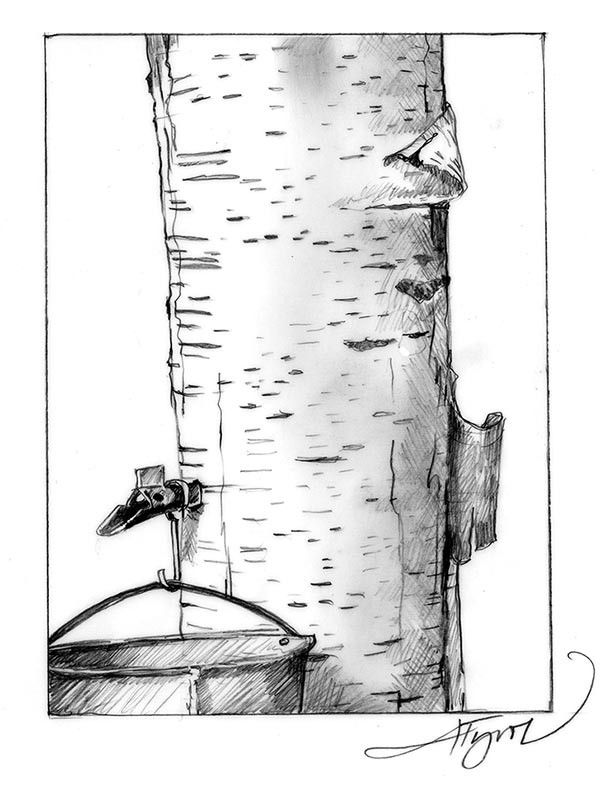
In Leicester, Vermont, up a rutted driveway off Route 7, Kevin New cobbled together a sugarhouse out of an old goat barn and plywood. He boiled a lot of sap this spring, long after most sugarhouses had gone dormant. In fact, he boiled into April, close to when the leaves came out. For his labors, he points to a neat double row of mason jars he has for sale along the back window of his shack. They’re filled with rich, red, birch syrup.
Yes, birch syrup.
New is part of a new wave of sugarmakers who are adding birch trees to their sugarbush portfolio. There’s enough promise in the pursuit that the University of Vermont’s Proctor Maple Research Center has begun doing experiments to find out how much sap — and sugar — birch trees produce.
Birch syrup has been made for decades by a handful of producers in Alaska, British Columbia, and other spots in Canada, but researchers at Proctor wants to determine if birch syrup can be profitable in New England using modern maple syrup equipment, like vacuum tubing and reverse osmosis machines.
The water content of birch sap is a challenge. Typically, 40to 60gallons of maple sap yield one gallon of syrup. This spring, New averaged 116 gallons of birch sap to make one gallon of syrup,which means a lot of time in the sugarhouse, and, for traditional sugarmakers, a mighty big stack of cordwood. Birch sap is also higher in fructose than maple sap, which means it scorches more easily.
The reward is in the price. One major Alaskan producer gets $328 for a gallon. Last year, David Moore, a birch syrup producer in Lee, New Hampshire, charged $20 for an eight-ounce glass bottle. This year, he’s upped his price to $25 because his season was cut short by80° F temperatures.
Maple syrup producers rely on a cycle of frosty nights and warmer days before the trees bud.Birch sap is a bit different: it tends to flow once below-freezing weather comes to an end.
“Most years, when I’m putting in my birch taps, my neighbors are pulling out their maple taps,” Moore said. Still, this spring’s sudden,very hot weather was tough on birch syrup makers, too. He made less than a gallon, when in other years he’s made five.
“I tend to sell out quick,” Moore said.He’s already sold half of this year’s supply. When he first started making birch syrup in 2008, he was an undergraduate at the University of New Hampshire. “It was difficult to find customers and get the word out,” but with some visits to chefs and farmers markets, “now it’s easy,” he said.
It’s not hard to imagine that other ambitious producers will find birch syrup attractive. They could wind down their traditional six- or eight-week maple season, clean their gear, and head right into birch for another round of two to three weeks.
Now you may be asking yourself the same question I was: “What’s the stuff taste like?”Before you go hunting for a jar of birch syrup and start whipping up your favorite buttermilk batter, consider this:“It’s kind of a waste to put it on pancakes,” said one of Moore’s best customers, Evan Mallett.
Mallett’s the chef at Black Trumpet Bistro in Portsmouth, New Hampshire. Still, his warning doesn’t mean birch syrup isn’t tasty. “I’ve thought of myriad applications for it,” he said.
Mallett calls it a “dark flavor” and treats it a bit like molasses. His most recent incarnation is a raisin mostarda: a traditional northern Italian condiment that he likes to serve with cheese to his customers. “The roundness and molasses effect of the birch syrup is great for neutralizing the sharpness of the mustard seed,” he explained.
“It’s not maple,” said New. Instead, he calls birch syrup spicy and fruity. “Some people call it tangy.”
Bob Rook, the owner of Emack and Bolio’s ice cream in Boston, thinks birch syrup is delicious. Last year, he made a20-gallon batch of birch-walnut ice cream, and his customers liked it.
“For my taste buds, it was more intense and better in flavor than maple,” Rook said. “The problem with birch syrup is that it’s very, very expensive.” If more maple syrup producers hear his message, the laws of syrup supply and ice cream demand might just get the price down to where he’d churn another batch.


Discussion *